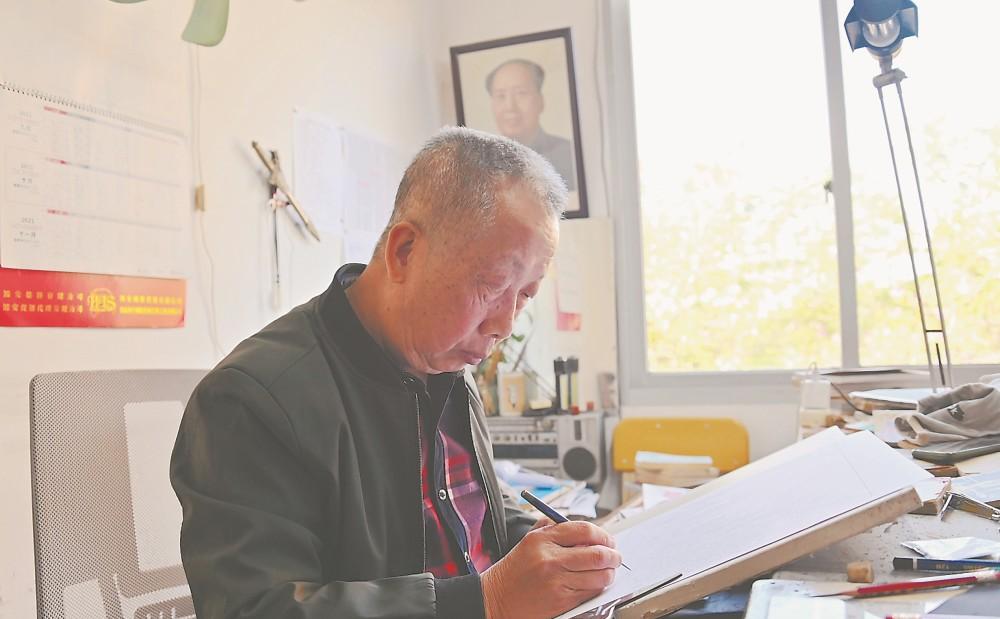
Huang Zaoshun is in the process of creation.
At the beginning of the new year, the reporter came to the studio of Zhangzhou comic strip artist Huang Zaoshun in Zhangpu. He has been working tirelessly for decades, and his studio is full of paintings and books. On the workbench, he is displaying the gu wenchang materials he has collected and the painting of "Gu Wenchang" in his creation.
"It is better to live in poverty than to dedicate good spiritual food to society." This is the evaluation of Huang Zaoshun by Jiang Weipu, president of the Chinese Comic Strip Research Association. Huang Zaoshun said that he regarded the creation of "Gu Wenchang" as a mission, so that the story of "Gu Gong" would be engraved on the comic strip and passed down.
Once a carpenter, the masterpiece was passed down to the local area
Comic strips, commonly known as "villain books", are usually 64 open sheets of paper, with open pages, pocket size, and one hand. The painting style of the white brush, supplemented by three or five lines of text, narrates the story and portrays the characters with continuous pictures, with a wide range of themes and diverse contents, suitable for all ages. After the founding of New China, this popular art with great national characteristics has been greatly developed, producing a large number of excellent works and influencing the growth of several generations.
Huang Zaoshun has been a "die-hard" to comic strips since he was a child. Born in 1953, he has a special love for painting since childhood, although he dropped out of junior high school to follow his father as a carpenter, but he also drew a few strokes from time to time in his spare time. His father then hired a painter friend to teach him. The painter told Huang Zaoshun: "You can paint whatever you see." This sentence has always been firmly remembered by him. Since then, while observing the surrounding environment and people, he has quickly sketched out what he has seen and heard. As soon as some of the pictures flashed by, he relied on his memories to memorize the scenes in his mind, and then painted them under the kerosene lamp after the end of the night. This exercise experience inadvertently improved his ability to summarize the picture and laid a solid foundation for his later comic strips.
Opportunities are always left to those who are prepared. In 1973, when the deeds of the female militia in Xia'an Village of Gulei Town were well-known, Professor Xie Yijia, a famous painter of Fujian Normal University, and Yang Qiyu and others followed the deeds of the Xia'an Female Militia to experience life in the fishing village of Gulei Peninsula, and happened to see Huang Zaoshun's painting on the wooden board. This little carpenter with spirit and willingness to endure hardships was recognized by them at a glance. Subsequently, Huang Zaoshun became Professor Xie Yijia's proud protégé. During his college years, Huang Zaoshun eagerly absorbed the nutrients of art, and his painting ability also improved by leaps and bounds, and he determined the direction of drawing comic strips according to the advice of his mentor. After graduation, Huang Zaoshun became an art teacher at Zhangpu No.1 Middle School.
During his teaching, Huang Zaoshun's brush never stopped. Since creating his first work in 1983, "Young Hero Huang Shuhua", he has successively created 9 works, including "Zodiac Week", "Kaizhang Saint King Chen Yuanguang", "Sanping Zushi", "Qing Dynasty Famous Minister Li Guangdi", "Legend of Master Liuzu Huineng", and "Mazu".
Remember the "Gu Gong" love book to commemorate it
Comic book creators, in addition to having a high level of painting technology, astronomy, geography, history, literature, etc. must be knowledgeable, and the most important thing is to have a heart of fame and fortune. In just a dozen years, comic strips have gradually faded from popular bestsellers to people's vision, and the gaps and difficulties in them have made Huang Zaoshun wander, but he has always insisted. "Always thinking about making money, how can you calm down and draw a good comic strip?"
Huang Zaoshun said that because Gu Wenchang's first stop in Fujian was the current Gulei Development Zone, and he was a native of Gulei, he had always had the idea of creating a comic strip with the theme of "Gu Gong". The original small fishing village has become a hot land full of hope and vigorous development, which has also given him greater creative motivation.
To paint historical figures well, we must not only have painters, but also have a foundation for life. Talking about the creation of "Gu Wenchang", Huang Zaoshun regrets most that he did not collect Gu Wenchang's deeds in Gulei in time in his early years, and now most of the elders of the same era as "Gu Gong" are no longer alive. "Fortunately, I grew up in that era and experienced the same environmental and social background, and although the clothing, farming tools, and fishing nets and fishing boats that went to the sea were very different from now, I can describe them in my mind from memory." He made up his mind that he must truly restore the image of Gu Wenchang's communist monument through comic strips.
As a comic strip (professor-level) researcher of the Institute of Arts and Crafts of Fuzhou University and a specially invited think tank expert of the provincial comic strip illustration and picture book talent think tank, Huang Zaoshun alone has to complete systematic projects such as editing, directing, acting, serving, beauty and scenery. He was meticulous in setting scripts and drawing storyboards. At present, "Gu Wenchang" has finalized 138 paintings, and it is expected to complete the creation of the painting in the first half of this year.